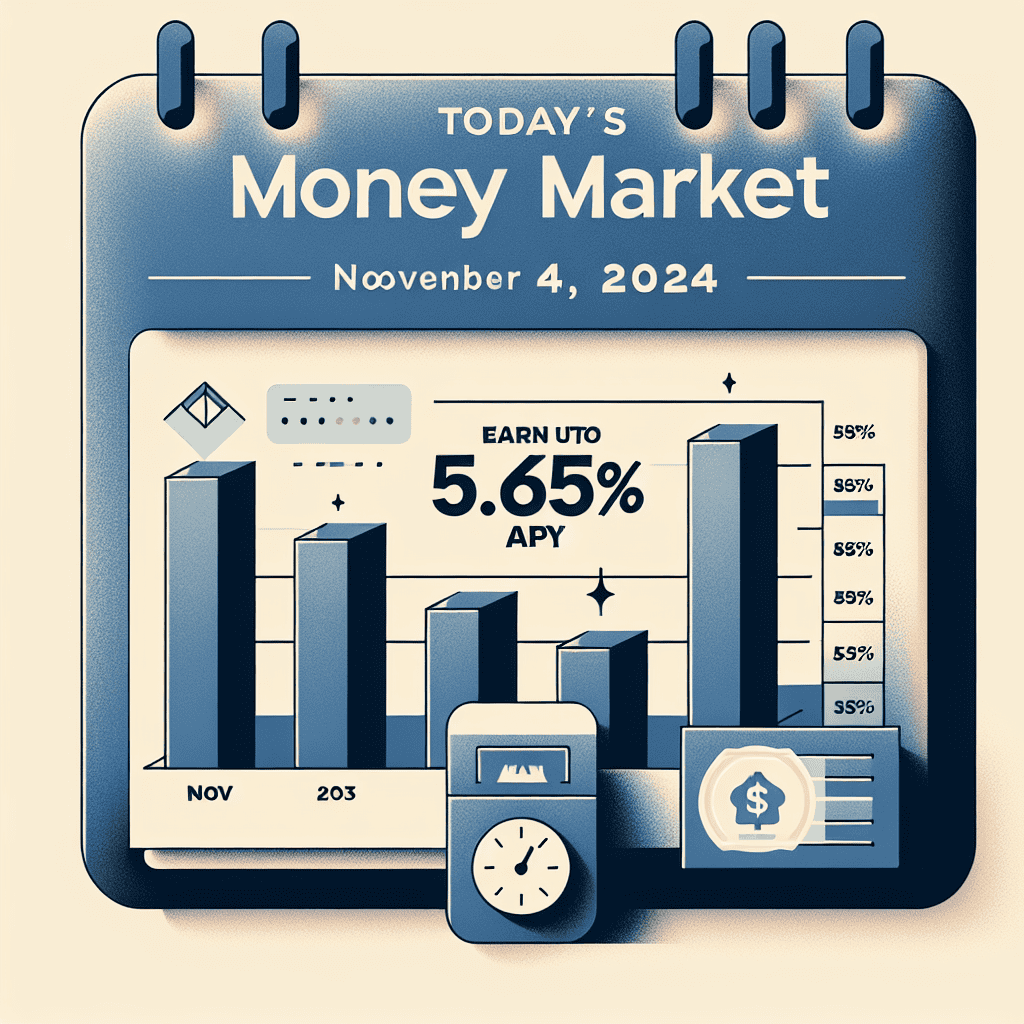“Maximize Your Savings: Secure Up to 5.05% APY with Today’s Money Market Accounts!”
Introduction
As of November 4, 2024, money market accounts are offering competitive interest rates, with some institutions providing annual percentage yields (APYs) as high as 5.05%. These accounts, known for their blend of savings and checking account features, are attracting attention from savers looking to maximize their returns while maintaining liquidity. The current economic climate, characterized by fluctuating interest rates and market conditions, has prompted financial institutions to adjust their offerings, making money market accounts an attractive option for those seeking both security and higher yields. This trend reflects a broader shift in the financial landscape, where consumers are increasingly prioritizing accounts that offer both flexibility and enhanced earning potential.
Understanding Money Market Accounts: A Guide to Earning 5.05% APY
In the ever-evolving landscape of personal finance, money market accounts (MMAs) have emerged as a compelling option for individuals seeking a balance between liquidity and higher interest rates. As of November 4, 2024, these accounts offer an attractive annual percentage yield (APY) of up to 5.05%, making them a noteworthy consideration for savers. Understanding the nuances of money market accounts is essential for those looking to maximize their earnings while maintaining access to their funds.
Money market accounts are a type of deposit account offered by banks and credit unions, combining features of both savings and checking accounts. They typically offer higher interest rates than traditional savings accounts, which is particularly appealing in today’s economic climate where maximizing returns is a priority for many. The current APY of up to 5.05% is a reflection of competitive market conditions and the institutions’ desire to attract more deposits. This rate is significantly higher than the national average for savings accounts, making MMAs an attractive option for those looking to grow their savings more efficiently.
One of the key advantages of money market accounts is their liquidity. Unlike certificates of deposit (CDs), which require funds to be locked in for a specified term, MMAs allow account holders to access their money with relative ease. This flexibility is particularly beneficial for individuals who may need to make occasional withdrawals or write checks against their account. However, it is important to note that MMAs often come with certain limitations, such as a restricted number of transactions per month. These restrictions are in place to maintain the account’s status as a savings vehicle rather than a transactional account.
In addition to their attractive interest rates and liquidity, money market accounts are also insured by the Federal Deposit Insurance Corporation (FDIC) or the National Credit Union Administration (NCUA), depending on the institution. This insurance provides a layer of security, ensuring that deposits are protected up to the maximum allowed by law. For risk-averse individuals, this feature adds an extra level of confidence in choosing an MMA as a savings option.
When considering a money market account, it is crucial to compare offerings from different financial institutions. While the headline APY of 5.05% is enticing, other factors such as minimum balance requirements, fees, and additional account features should also be taken into account. Some institutions may require a higher minimum balance to qualify for the best rates, while others might offer tiered interest rates based on the account balance. Additionally, understanding any associated fees, such as monthly maintenance fees or penalties for exceeding transaction limits, is essential to ensure that the account aligns with one’s financial goals and usage patterns.
In conclusion, money market accounts present a viable option for individuals seeking to earn higher interest rates while maintaining access to their funds. The current APY of up to 5.05% is a testament to the competitive nature of the financial market and the opportunities available to savvy savers. By carefully evaluating the terms and conditions of various MMAs, individuals can make informed decisions that align with their financial objectives, ultimately enhancing their ability to grow their savings in a secure and flexible manner. As with any financial product, due diligence and a clear understanding of one’s needs are paramount in selecting the most suitable money market account.
Comparing Money Market Account Rates: How to Maximize Your Earnings
In the ever-evolving landscape of personal finance, money market accounts (MMAs) have emerged as a popular choice for individuals seeking a balance between liquidity and higher interest rates. As of November 4, 2024, these accounts offer competitive annual percentage yields (APYs), with some institutions providing rates as high as 5.05%. Understanding how to navigate and compare these rates is crucial for maximizing your earnings and ensuring your financial strategy aligns with your goals.
To begin with, money market accounts are a type of savings account that typically offer higher interest rates than traditional savings accounts. They achieve this by investing in short-term, low-risk securities, which allows financial institutions to pass on higher returns to account holders. However, these accounts often come with certain restrictions, such as higher minimum balance requirements and limited transaction capabilities. Therefore, when comparing money market account rates, it is essential to consider not only the APY but also the terms and conditions associated with each account.
One of the primary factors to consider is the minimum balance requirement. Many institutions offer tiered interest rates, meaning the APY increases with higher account balances. For instance, an account might offer a 4.00% APY for balances up to $10,000, but increase to 5.05% for balances exceeding $50,000. Consequently, understanding your financial capacity to maintain a certain balance can significantly impact your potential earnings. Additionally, some accounts may impose fees if the balance falls below a specified threshold, which could negate the benefits of a higher interest rate.
Another critical aspect is the liquidity and accessibility of funds. While money market accounts generally allow for more flexibility than certificates of deposit (CDs), they still have limitations. Federal regulations typically restrict the number of withdrawals or transfers to six per month. Therefore, if you anticipate needing frequent access to your funds, it is vital to ensure that these limitations align with your financial habits. Moreover, some institutions may offer check-writing privileges or debit card access, providing additional convenience for account holders.
Furthermore, it is important to consider the financial institution’s reputation and stability. Opting for a well-established bank or credit union can provide peace of mind, knowing that your funds are secure. Additionally, ensuring that the institution is insured by the Federal Deposit Insurance Corporation (FDIC) or the National Credit Union Administration (NCUA) is crucial, as this insurance protects your deposits up to $250,000 per account holder, per institution.
In addition to these considerations, staying informed about market trends and economic conditions can also influence your decision. Interest rates are subject to change based on the Federal Reserve’s monetary policy and other economic factors. Therefore, keeping an eye on these developments can help you make timely decisions about when to open or switch accounts to take advantage of favorable rates.
In conclusion, while today’s money market account rates offer attractive opportunities to earn up to 5.05% APY, maximizing your earnings requires a comprehensive evaluation of various factors. By considering minimum balance requirements, liquidity needs, institutional stability, and market trends, you can make informed decisions that align with your financial objectives. As you navigate the options available, remember that the right money market account can serve as a valuable component of your broader financial strategy, providing both growth and security for your savings.
The Benefits of High-Yield Money Market Accounts in 2024
In the ever-evolving landscape of personal finance, high-yield money market accounts have emerged as a compelling option for individuals seeking both security and growth for their savings. As of November 4, 2024, these accounts offer attractive annual percentage yields (APY), with some institutions providing rates as high as 5.05%. This development marks a significant opportunity for savers to maximize their returns while maintaining liquidity and minimizing risk.
To begin with, high-yield money market accounts combine the best features of savings and checking accounts, offering a unique blend of benefits. Unlike traditional savings accounts, which often provide lower interest rates, money market accounts typically offer higher yields, making them an appealing choice for those looking to grow their savings more effectively. The current rates, reaching up to 5.05% APY, are particularly enticing in today’s economic climate, where inflation concerns and market volatility have prompted many to seek stable yet rewarding financial products.
Moreover, money market accounts provide a level of flexibility that is not always available with other high-yield options, such as certificates of deposit (CDs). While CDs require funds to be locked in for a predetermined period, money market accounts allow for easier access to funds, often with limited check-writing capabilities and debit card access. This liquidity is a crucial advantage for individuals who may need to access their savings for unexpected expenses or investment opportunities without incurring penalties.
In addition to their attractive yields and flexibility, money market accounts are also known for their safety. They are typically insured by the Federal Deposit Insurance Corporation (FDIC) up to the maximum allowed by law, providing peace of mind to account holders. This insurance ensures that even in the unlikely event of a bank failure, the depositor’s funds are protected, making money market accounts a secure choice for risk-averse savers.
Furthermore, the competitive rates offered by money market accounts in 2024 can be attributed to several economic factors. As the Federal Reserve continues to adjust interest rates in response to inflationary pressures, financial institutions are incentivized to offer higher yields to attract deposits. This environment creates a favorable scenario for consumers, who can benefit from increased returns on their savings without having to navigate the complexities of more volatile investment vehicles.
It is also worth noting that the accessibility of high-yield money market accounts has been enhanced by the digital transformation of banking services. Many financial institutions now offer online platforms that make it easy for consumers to open and manage accounts from the comfort of their homes. This convenience, coupled with competitive rates, has contributed to the growing popularity of money market accounts among tech-savvy savers.
In conclusion, high-yield money market accounts in 2024 present a compelling option for individuals seeking to optimize their savings strategy. With rates reaching up to 5.05% APY, these accounts offer a combination of high returns, liquidity, and security that is difficult to match. As economic conditions continue to evolve, money market accounts remain a prudent choice for those looking to balance growth and safety in their financial portfolios. By taking advantage of the current favorable rates, savers can effectively enhance their financial well-being while maintaining the flexibility to adapt to future financial needs.
How to Choose the Best Money Market Account for Your Financial Goals

In the ever-evolving landscape of personal finance, selecting the right money market account (MMA) is crucial for achieving your financial goals. As of November 4, 2024, money market account rates have reached impressive heights, with some institutions offering up to 5.05% annual percentage yield (APY). This presents a compelling opportunity for savers to maximize their returns while maintaining liquidity. However, choosing the best money market account requires careful consideration of several factors to ensure it aligns with your financial objectives.
To begin with, understanding the fundamental characteristics of money market accounts is essential. MMAs are a type of savings account that typically offer higher interest rates compared to traditional savings accounts. They provide the flexibility of limited check-writing capabilities and debit card access, making them an attractive option for those who seek both growth and accessibility. However, it is important to note that these accounts often require a higher minimum balance to open and maintain, which can be a determining factor for many potential account holders.
When evaluating money market accounts, the interest rate is undoubtedly a primary consideration. With rates as high as 5.05% APY currently available, it is tempting to gravitate towards the highest offer. Nevertheless, it is crucial to examine the terms and conditions associated with these rates. Some financial institutions may offer promotional rates that are only applicable for a limited time or require maintaining a substantial balance to qualify. Therefore, it is advisable to read the fine print and ensure that the rate is sustainable and aligns with your long-term financial strategy.
In addition to interest rates, fees associated with money market accounts can significantly impact your overall returns. Common fees include monthly maintenance fees, excessive transaction fees, and penalties for falling below the minimum balance requirement. To optimize your earnings, it is prudent to select an account with minimal fees or one that waives fees under certain conditions, such as setting up direct deposits or maintaining a specified balance.
Furthermore, the financial stability and reputation of the institution offering the money market account should not be overlooked. Opting for a well-established bank or credit union with a strong track record can provide peace of mind, knowing that your funds are secure. Additionally, ensuring that the institution is insured by the Federal Deposit Insurance Corporation (FDIC) or the National Credit Union Administration (NCUA) is vital, as this insurance protects your deposits up to the legal limit in the event of a bank failure.
Another aspect to consider is the accessibility and convenience of managing your money market account. In today’s digital age, having access to a robust online banking platform or mobile app can enhance your banking experience. Features such as easy fund transfers, mobile check deposits, and real-time account monitoring can make managing your finances more efficient and less time-consuming.
Ultimately, choosing the best money market account involves a careful balance of interest rates, fees, institutional reliability, and accessibility. By thoroughly evaluating these factors, you can select an account that not only offers competitive returns but also aligns with your financial goals and lifestyle. As money market account rates continue to fluctuate, staying informed and periodically reviewing your options will ensure that your savings strategy remains effective and adaptable to changing market conditions.
Money Market Accounts vs. Savings Accounts: Which Offers Better Returns?
In the ever-evolving landscape of personal finance, individuals are constantly seeking the most effective ways to grow their savings. As of November 4, 2024, money market accounts (MMAs) have emerged as a compelling option, offering attractive annual percentage yields (APYs) of up to 5.05%. This development prompts a closer examination of how money market accounts compare to traditional savings accounts in terms of returns and overall benefits.
To begin with, it is essential to understand the fundamental differences between money market accounts and savings accounts. Both are designed to help individuals save money while earning interest, yet they differ in their structure and potential returns. Savings accounts are typically straightforward, offering a fixed interest rate with minimal requirements. In contrast, money market accounts often provide higher interest rates, such as the current 5.05% APY, but may require a higher minimum balance and offer limited check-writing capabilities.
The primary allure of money market accounts lies in their potential for higher returns. With interest rates fluctuating in response to economic conditions, MMAs have become increasingly competitive. The current rate of 5.05% APY is particularly appealing in a financial environment where maximizing returns is crucial. This rate significantly surpasses the average savings account interest rate, which hovers around 0.50% APY. Consequently, for individuals with substantial savings, money market accounts present an opportunity to earn more on their deposits.
However, it is important to consider the trade-offs associated with money market accounts. While they offer higher interest rates, they often come with higher minimum balance requirements. This means that individuals must maintain a certain amount in their account to benefit from the elevated APY. Failure to meet these requirements can result in fees or a reduction in the interest rate, potentially diminishing the overall returns. Therefore, prospective account holders must assess their financial situation and ensure they can consistently meet these requirements.
Moreover, money market accounts provide a degree of liquidity that is comparable to savings accounts, albeit with some limitations. While both account types allow for easy access to funds, MMAs typically offer a limited number of transactions per month. This restriction is due to federal regulations, which aim to maintain the stability of these accounts. As a result, individuals who anticipate frequent withdrawals may find savings accounts more suitable for their needs.
In addition to these considerations, it is worth noting that both money market accounts and savings accounts are insured by the Federal Deposit Insurance Corporation (FDIC) up to $250,000 per depositor, per institution. This insurance provides a layer of security, ensuring that account holders’ funds are protected in the event of a bank failure. Therefore, the choice between the two account types should primarily hinge on the individual’s financial goals and preferences.
In conclusion, the decision between money market accounts and savings accounts ultimately depends on one’s financial objectives and circumstances. With money market accounts currently offering up to 5.05% APY, they present an attractive option for those seeking higher returns on their savings. However, the associated requirements and transaction limitations necessitate careful consideration. By weighing the potential benefits against the constraints, individuals can make informed decisions that align with their financial aspirations, ensuring that their savings work effectively for them in today’s dynamic economic environment.
The Impact of Interest Rate Changes on Money Market Accounts
In the ever-evolving landscape of personal finance, money market accounts (MMAs) have long been a favored choice for individuals seeking a balance between liquidity and higher interest rates. As of November 4, 2024, these accounts are offering attractive annual percentage yields (APYs) of up to 5.05%. This development is particularly noteworthy in the context of recent interest rate changes, which have had a significant impact on the returns offered by MMAs. Understanding the dynamics of these changes is crucial for both current and prospective account holders.
To begin with, it is essential to recognize that money market accounts are influenced by the broader interest rate environment, which is largely dictated by central bank policies. Over the past year, central banks around the world have adjusted their interest rates in response to varying economic conditions, including inflationary pressures and economic growth forecasts. These adjustments have a direct impact on the rates that financial institutions can offer on MMAs. When central banks raise interest rates, banks typically follow suit by increasing the rates on their deposit products, including money market accounts. This is because higher central bank rates increase the cost of borrowing for banks, which in turn incentivizes them to offer more attractive rates to depositors to secure funding.
Moreover, the competitive landscape among financial institutions also plays a crucial role in determining MMA rates. As banks vie for customers’ deposits, they often adjust their rates to remain competitive. In recent months, the competition has intensified, with many banks striving to offer the most appealing rates to attract new customers and retain existing ones. This competitive pressure has contributed to the current high APYs available on money market accounts, making them an attractive option for savers looking to maximize their returns.
In addition to these factors, the overall economic climate has a significant influence on interest rates and, consequently, on money market accounts. In periods of economic expansion, central banks may raise interest rates to prevent the economy from overheating, which can lead to higher MMA rates. Conversely, during economic downturns, central banks may lower rates to stimulate growth, resulting in lower returns on these accounts. As such, the current economic environment, characterized by moderate growth and controlled inflation, has created a favorable backdrop for higher MMA rates.
Furthermore, it is important to consider the implications of these interest rate changes for account holders. Higher MMA rates can provide a substantial boost to savers’ returns, particularly for those with significant balances. However, it is also crucial for account holders to remain vigilant and informed about potential future rate changes. Interest rates are inherently variable, and shifts in economic conditions or central bank policies can lead to adjustments in MMA rates. Therefore, staying informed about economic trends and central bank announcements can help account holders make informed decisions about their savings strategies.
In conclusion, the current high APYs of up to 5.05% on money market accounts reflect a confluence of factors, including central bank policies, competitive pressures among financial institutions, and the prevailing economic climate. These elements collectively shape the interest rate landscape, influencing the returns available to savers. As such, understanding the impact of interest rate changes on money market accounts is essential for individuals seeking to optimize their savings and make informed financial decisions in today’s dynamic economic environment.
Tips for Opening a Money Market Account with Competitive Rates
When considering the opening of a money market account, particularly in today’s financial landscape where rates can reach up to 5.05% APY, it is crucial to approach the process with a strategic mindset. Money market accounts offer a unique blend of features, combining the benefits of both savings and checking accounts, which can be highly advantageous for individuals seeking to maximize their returns while maintaining liquidity. To ensure you secure a competitive rate, it is essential to conduct thorough research and consider several key factors.
First and foremost, understanding the current market conditions is imperative. Interest rates on money market accounts are influenced by a variety of economic factors, including the Federal Reserve’s monetary policy and overall economic health. As of November 2024, the financial environment is characterized by relatively high interest rates, making it an opportune time to explore money market accounts. By staying informed about these conditions, you can better anticipate rate fluctuations and make informed decisions.
In addition to market awareness, comparing offerings from different financial institutions is a critical step. Banks and credit unions often provide varying rates and terms, so it is beneficial to shop around. Online banks, in particular, tend to offer higher rates due to their lower overhead costs. Utilizing comparison tools and resources can aid in identifying institutions that offer the most competitive rates. Furthermore, it is advisable to examine the account’s fee structure, as fees can significantly impact the overall yield. Look for accounts with minimal or no monthly maintenance fees to maximize your earnings.
Another important consideration is the account’s minimum balance requirement. Money market accounts often require a higher minimum balance than traditional savings accounts. It is essential to ensure that you can comfortably meet this requirement, as failing to do so may result in lower interest rates or additional fees. Balancing the need for a competitive rate with your financial capabilities is key to selecting the right account.
Moreover, evaluating the account’s accessibility features is crucial. Money market accounts typically offer check-writing privileges and debit card access, providing greater flexibility compared to standard savings accounts. However, federal regulations limit the number of certain types of withdrawals and transfers to six per month. Understanding these limitations and how they align with your financial habits will help you make the most of your account.
Additionally, consider the institution’s reputation and customer service quality. A bank or credit union with a strong reputation for customer service can provide peace of mind and support should any issues arise. Reading reviews and seeking recommendations can offer valuable insights into the experiences of other account holders.
Finally, it is wise to periodically review your money market account’s performance. Interest rates and financial needs can change over time, so reassessing your account’s competitiveness and suitability is a prudent practice. By staying proactive and adaptable, you can ensure that your money market account continues to serve your financial goals effectively.
In conclusion, opening a money market account with a competitive rate requires careful consideration of market conditions, institutional offerings, and personal financial needs. By conducting thorough research and evaluating key factors such as fees, minimum balance requirements, accessibility, and customer service, you can make an informed decision that maximizes your financial returns while providing the flexibility and security you desire.
Q&A
1. **What is the highest APY available for money market accounts today?**
– The highest APY available is 5.05%.
2. **Which banks are offering competitive money market account rates?**
– Several banks are offering competitive rates, but specific names are not provided.
3. **How does the current top APY compare to historical rates?**
– The current top APY of 5.05% is relatively high compared to historical averages.
4. **What factors influence money market account rates?**
– Factors include the Federal Reserve’s interest rate policies, economic conditions, and bank-specific strategies.
5. **Are there any fees associated with these high-yield money market accounts?**
– Some accounts may have fees, but many high-yield options offer fee waivers under certain conditions.
6. **What is the typical minimum balance requirement for these accounts?**
– Minimum balance requirements vary, but many high-yield accounts require a balance of $1,000 or more.
7. **How often do money market account rates change?**
– Rates can change frequently, often in response to shifts in the broader interest rate environment.
Conclusion
As of November 4, 2024, money market account rates have reached competitive levels, with some institutions offering up to 5.05% APY. This increase in rates reflects broader economic conditions, including central bank policies and market demand for higher yields. For savers, this presents an opportunity to earn more on their deposits compared to traditional savings accounts, making money market accounts an attractive option for those seeking both liquidity and higher returns. However, it’s important for consumers to compare terms and conditions across different financial institutions to ensure they are maximizing their earnings while considering any potential fees or restrictions.





